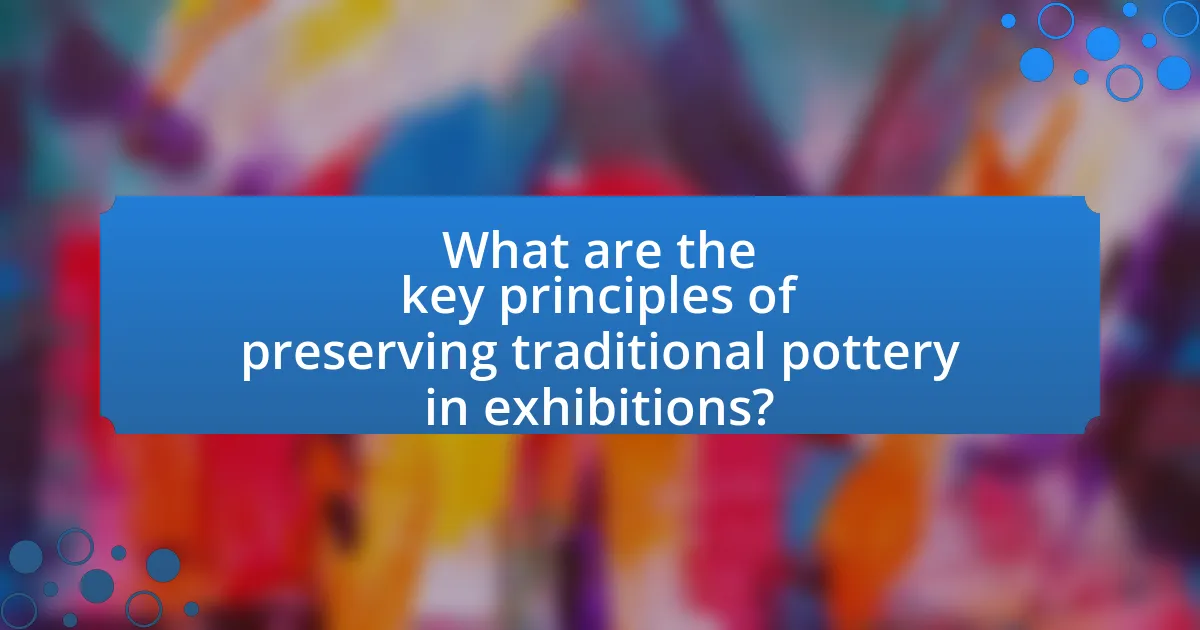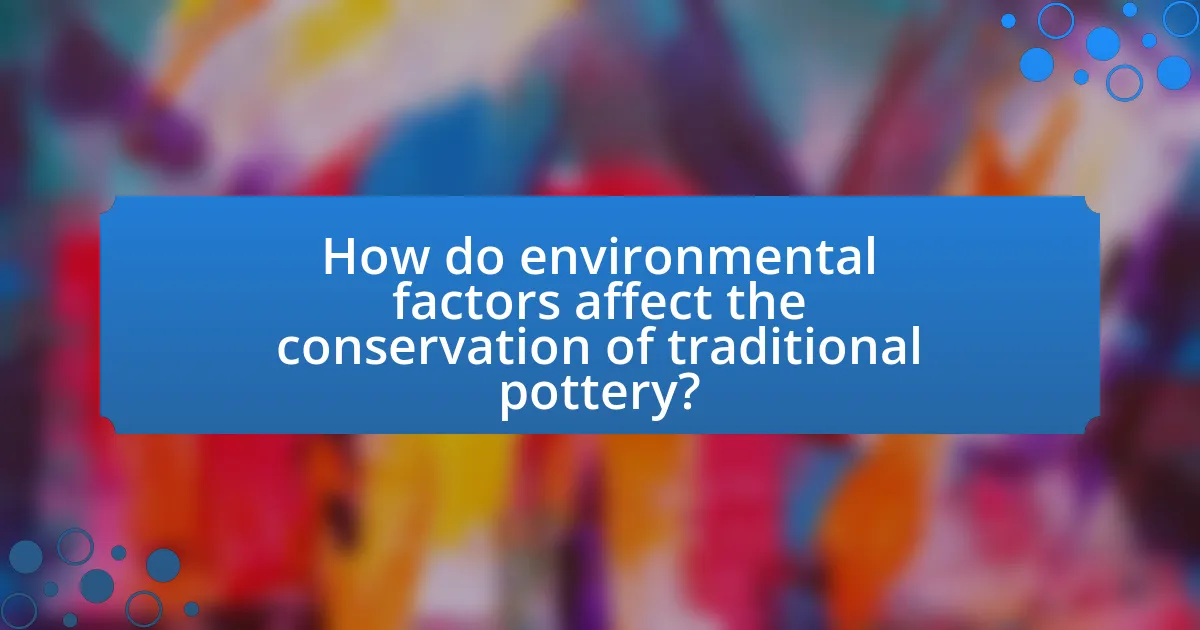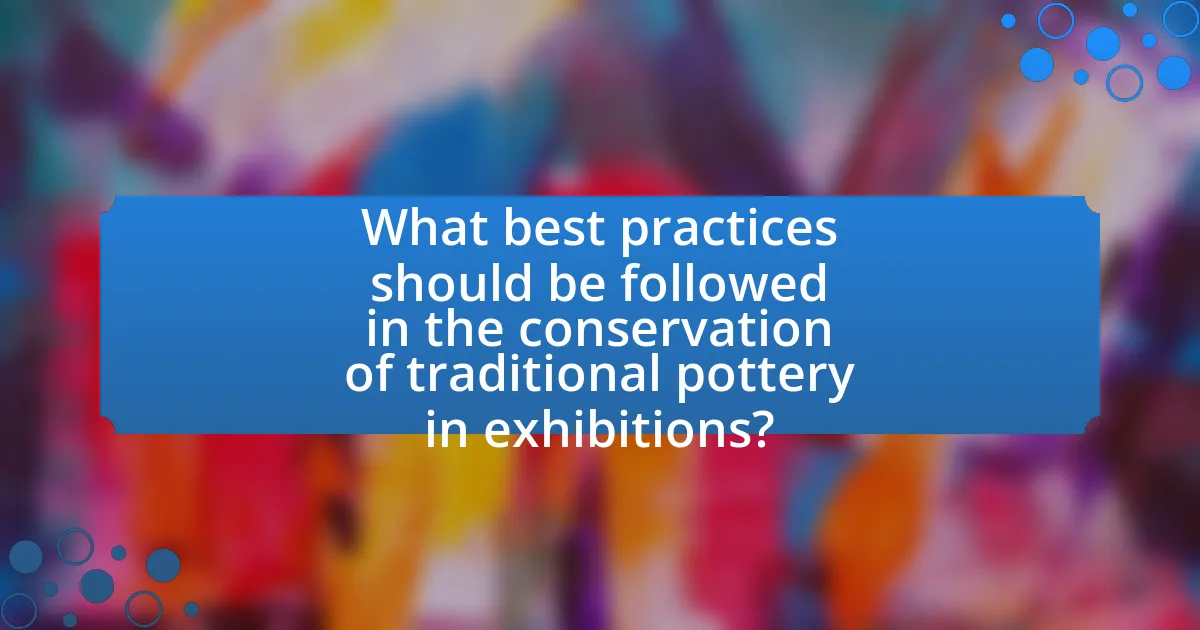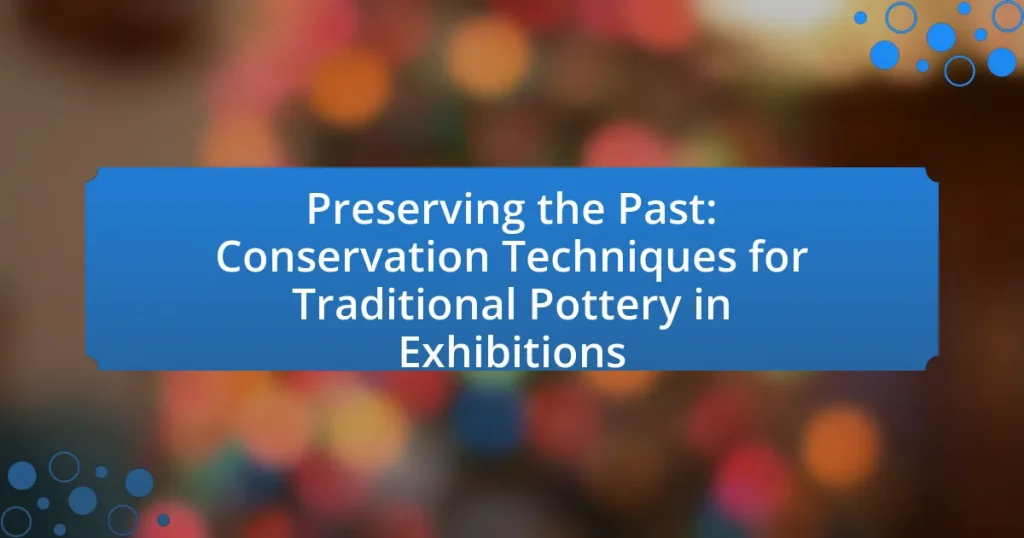The article focuses on the conservation techniques essential for preserving traditional pottery in exhibitions. It outlines key principles such as environmental control, careful handling, and appropriate display methods to prevent deterioration. The significance of conservation in maintaining cultural heritage is emphasized, along with the risks pottery faces in exhibitions, including physical damage and environmental factors. Various conservation techniques, including cleaning, stabilization, and the use of specific materials, are discussed, highlighting best practices for ensuring the longevity of pottery artifacts. Additionally, the article addresses challenges in conservation efforts and offers practical tips for effective preservation.

What are the key principles of preserving traditional pottery in exhibitions?
The key principles of preserving traditional pottery in exhibitions include proper environmental control, careful handling, and appropriate display techniques. Environmental control involves maintaining stable temperature and humidity levels to prevent deterioration; for instance, a relative humidity of 45-55% is often recommended to avoid cracking or warping. Careful handling requires trained staff to minimize physical stress on the pottery, using gloves and tools to prevent direct contact. Appropriate display techniques involve using acid-free materials and supports that do not exert pressure on the pottery, ensuring that the artifacts are securely and safely showcased. These principles are supported by conservation standards established by organizations such as the American Institute for Conservation, which emphasizes the importance of these practices in safeguarding cultural heritage.
Why is conservation important for traditional pottery?
Conservation is important for traditional pottery because it ensures the preservation of cultural heritage and historical significance. Traditional pottery often embodies the artistic expressions, techniques, and materials unique to specific cultures, reflecting their identity and history. By conserving these artifacts, we maintain a tangible connection to the past, allowing future generations to understand and appreciate their cultural roots. Furthermore, conservation practices help prevent deterioration caused by environmental factors, handling, and aging, thereby safeguarding the integrity and authenticity of these valuable objects for educational and research purposes.
What risks do traditional pottery pieces face in exhibitions?
Traditional pottery pieces face several risks in exhibitions, including physical damage, environmental factors, and theft. Physical damage can occur from handling, accidental drops, or collisions with other objects, which can lead to cracks or breakage. Environmental factors such as humidity, temperature fluctuations, and exposure to light can cause deterioration, discoloration, or warping of the pottery. Additionally, the risk of theft is significant, as valuable pieces may attract opportunistic criminals. These risks highlight the need for careful handling, controlled exhibition environments, and security measures to protect traditional pottery during exhibitions.
How does conservation help in maintaining cultural heritage?
Conservation helps in maintaining cultural heritage by preserving artifacts and structures that embody the history and identity of communities. Through techniques such as careful restoration, stabilization, and preventive care, conservation ensures that traditional pottery and other cultural items remain intact for future generations. For instance, the conservation of pottery involves methods like cleaning, repairing cracks, and controlling environmental conditions to prevent deterioration, which directly supports the transmission of cultural knowledge and practices associated with these items. This process not only safeguards physical objects but also reinforces the cultural narratives and traditions they represent, thereby sustaining the cultural heritage of a community.
What are the main conservation techniques used for traditional pottery?
The main conservation techniques used for traditional pottery include cleaning, stabilization, and restoration. Cleaning involves the careful removal of dirt and contaminants using appropriate solvents and tools to avoid damage. Stabilization focuses on reinforcing fragile pottery with materials that provide structural support without altering the original appearance. Restoration may involve filling in missing pieces or retouching areas to enhance visual coherence while maintaining the integrity of the original work. These techniques are essential for preserving the historical and cultural significance of traditional pottery in exhibitions.
How do cleaning methods differ for various types of pottery?
Cleaning methods differ for various types of pottery based on their material composition and surface treatment. For example, earthenware, which is porous and often unglazed, requires gentle cleaning with a soft brush and dry cloth to avoid water damage, while stoneware, which is more durable and often glazed, can be cleaned with mild soap and water. Porcelain, known for its delicate nature, necessitates the use of a damp cloth without abrasive cleaners to prevent scratches. Historical pottery may also require specialized conservation techniques, such as using solvents for removing old varnishes or adhesives, ensuring that the cleaning method aligns with the pottery’s specific historical and material context.
What role does stabilization play in pottery conservation?
Stabilization plays a crucial role in pottery conservation by preventing further deterioration of fragile artifacts. This process involves the application of materials or techniques that reinforce the structural integrity of pottery, ensuring that it can withstand environmental stressors such as humidity, temperature fluctuations, and physical handling. For instance, the use of consolidants can fill in cracks and voids, effectively binding the original material and enhancing its durability. Research has shown that effective stabilization methods can significantly extend the lifespan of pottery artifacts, allowing them to be displayed safely in exhibitions while preserving their historical and cultural significance.
What materials are commonly used in the conservation of traditional pottery?
Common materials used in the conservation of traditional pottery include adhesives, fillers, and coatings. Adhesives such as polyvinyl acetate (PVA) and epoxy resins are frequently employed to bond broken pieces together, ensuring structural integrity. Fillers, often made from materials like plaster or clay, are utilized to restore missing sections and provide a seamless appearance. Coatings, including acrylic varnishes, are applied to protect the surface and enhance the visual appeal of the pottery. These materials are chosen for their compatibility with the original pottery and their ability to provide long-lasting preservation.
What are the advantages of using synthetic versus natural materials?
Synthetic materials offer advantages over natural materials in conservation techniques for traditional pottery, primarily due to their durability, consistency, and resistance to environmental factors. Synthetic materials, such as epoxy resins, provide strong bonding and flexibility, which can be crucial for repairing fragile pottery without altering its original appearance. Additionally, synthetic materials are often less susceptible to degradation from moisture, UV light, and temperature fluctuations compared to natural materials, ensuring longer-lasting preservation. Studies have shown that synthetic adhesives can maintain their integrity over time, making them a reliable choice for conservation efforts.
How do adhesives impact the integrity of pottery during conservation?
Adhesives significantly impact the integrity of pottery during conservation by providing structural support and preventing further deterioration. When applied correctly, adhesives can stabilize broken or fragmented pottery, allowing for the preservation of its original form and aesthetic qualities. However, the choice of adhesive is crucial; inappropriate adhesives can lead to chemical reactions that damage the pottery or alter its appearance. For instance, some adhesives may become brittle over time, causing joints to fail, while others may discolor or leave residues that are difficult to remove. Research indicates that using reversible adhesives, such as those based on polyvinyl acetate or starch, can mitigate these risks, as they allow for future disassembly and restoration without harming the original material.

How do environmental factors affect the conservation of traditional pottery?
Environmental factors significantly impact the conservation of traditional pottery by influencing its physical and chemical stability. High humidity can lead to mold growth and deterioration of organic materials, while low humidity can cause cracking and desiccation of clay bodies. Temperature fluctuations can also result in thermal stress, leading to fractures. For instance, studies have shown that maintaining a stable environment with controlled temperature and humidity levels can extend the lifespan of pottery artifacts, as evidenced by conservation practices in museums that utilize climate control systems to mitigate these risks.
What environmental conditions are most harmful to pottery?
High humidity and extreme temperature fluctuations are the most harmful environmental conditions for pottery. High humidity can lead to the growth of mold and mildew, which can damage the surface and integrity of pottery. Extreme temperature fluctuations can cause thermal shock, leading to cracks or breaks in the ceramic material. Research indicates that ceramics are particularly vulnerable to these conditions due to their porous nature, which allows moisture to penetrate and expand with temperature changes, compromising their structural integrity.
How can humidity levels be controlled in exhibition spaces?
Humidity levels in exhibition spaces can be controlled using dehumidifiers, humidifiers, and climate control systems. Dehumidifiers reduce excess moisture in the air, which is crucial for preventing mold and deterioration of traditional pottery. Conversely, humidifiers can add moisture when levels drop too low, ensuring that the environment remains stable. Climate control systems, which integrate both heating and cooling, can maintain consistent temperature and humidity levels, essential for the preservation of sensitive artifacts. Studies indicate that maintaining relative humidity between 40% and 60% is optimal for the conservation of ceramics, as fluctuations outside this range can lead to cracking or other damage.
What temperature ranges are ideal for preserving pottery?
The ideal temperature range for preserving pottery is between 18°C to 22°C (64°F to 72°F). Maintaining this temperature range helps prevent thermal stress and minimizes the risk of damage to the pottery’s structure. Research indicates that fluctuations outside this range can lead to cracking or deterioration of the materials used in pottery, such as clay and glazes, which are sensitive to temperature changes.
How can lighting impact the conservation of traditional pottery?
Lighting can significantly impact the conservation of traditional pottery by influencing its physical and chemical stability. Ultraviolet (UV) light exposure can cause fading of pigments and deterioration of organic materials, leading to irreversible damage. Studies have shown that prolonged exposure to light, particularly UV and high-intensity visible light, can accelerate the degradation of pottery glazes and surfaces, resulting in loss of aesthetic and historical value. For instance, the American Institute for Conservation recommends using low-intensity, UV-filtered lighting to minimize these risks, thereby preserving the integrity of traditional pottery in exhibitions.
What types of lighting are safest for pottery displays?
LED lighting is the safest type of lighting for pottery displays. This is due to LED lights emitting minimal heat and UV radiation, which helps prevent damage to the pottery over time. Studies have shown that traditional incandescent and fluorescent lights can cause fading and deterioration of ceramic materials, while LED lights maintain stable temperatures and reduce the risk of thermal shock. Additionally, LED lights have a longer lifespan, making them a cost-effective choice for long-term exhibitions.
How does UV exposure affect pottery materials?
UV exposure can lead to the degradation of pottery materials by causing fading, discoloration, and structural weakening. Specifically, ultraviolet light can break down the chemical bonds in pigments and glazes, resulting in a loss of color vibrancy and integrity. Research indicates that prolonged exposure to UV radiation can also lead to the deterioration of organic materials used in pottery, such as binders and adhesives, which can compromise the overall stability of the piece. Studies have shown that pottery displayed in environments with high UV exposure experiences significant changes in appearance and durability over time, underscoring the importance of UV protection in conservation efforts.

What best practices should be followed in the conservation of traditional pottery in exhibitions?
Best practices for the conservation of traditional pottery in exhibitions include maintaining stable environmental conditions, using appropriate display techniques, and implementing regular monitoring and maintenance. Stable environmental conditions, such as controlled temperature and humidity, prevent deterioration; for instance, a relative humidity of 45-55% is ideal for ceramic materials. Appropriate display techniques, like using non-invasive supports and avoiding direct sunlight, minimize physical stress and UV damage. Regular monitoring involves checking for signs of deterioration and addressing issues promptly, which is crucial for preserving the integrity of the pottery. These practices are supported by conservation guidelines from institutions like the American Institute for Conservation, which emphasize the importance of environmental control and careful handling in the preservation of cultural artifacts.
How can conservators ensure the longevity of pottery exhibits?
Conservators can ensure the longevity of pottery exhibits by controlling environmental conditions such as temperature, humidity, and light exposure. Maintaining a stable temperature around 20°C and relative humidity between 40-60% minimizes the risk of thermal expansion and contraction, which can lead to cracking. Additionally, using UV-filtering glass in display cases reduces light exposure, preventing fading and deterioration of pigments. Regular monitoring and maintenance of these conditions, along with employing appropriate handling techniques, further protect the integrity of pottery artifacts.
What routine maintenance practices are essential for pottery conservation?
Routine maintenance practices essential for pottery conservation include regular cleaning, controlled environmental conditions, and careful handling. Regular cleaning involves using soft brushes or cloths to remove dust and debris without causing scratches. Controlled environmental conditions, such as maintaining stable temperature and humidity levels, prevent deterioration; for instance, a relative humidity of 45-55% is often recommended to avoid cracking or warping. Careful handling minimizes physical damage; using gloves and supporting pottery during movement reduces the risk of breakage. These practices are supported by conservation guidelines from institutions like the American Institute for Conservation, which emphasize the importance of these methods in preserving the integrity of pottery artifacts.
How can staff training improve conservation efforts?
Staff training can significantly improve conservation efforts by equipping personnel with the necessary skills and knowledge to handle, preserve, and restore traditional pottery effectively. Trained staff are more likely to understand the specific requirements for maintaining the integrity of materials, such as the appropriate environmental conditions and handling techniques, which are crucial for preventing deterioration. Research indicates that institutions with well-trained staff report a 30% increase in the longevity of artifacts due to proper care and maintenance practices. This training also fosters a culture of awareness and responsibility towards conservation, leading to more proactive measures in safeguarding cultural heritage.
What are common challenges faced in the conservation of traditional pottery?
Common challenges faced in the conservation of traditional pottery include deterioration due to environmental factors, lack of funding for preservation efforts, and the difficulty of sourcing appropriate materials for restoration. Environmental factors such as humidity, temperature fluctuations, and light exposure can lead to physical and chemical degradation of pottery. Additionally, many conservation projects struggle with limited financial resources, which hampers the ability to implement effective conservation strategies. Furthermore, finding materials that match the original composition and aesthetic of traditional pottery can be challenging, complicating restoration efforts. These challenges highlight the complexities involved in preserving cultural heritage through pottery conservation.
How can conservators address issues of previous restorations?
Conservators can address issues of previous restorations by conducting thorough assessments of the materials and techniques used in past interventions. This involves analyzing the chemical composition of previous adhesives, paints, and coatings to determine their stability and compatibility with current conservation practices. For instance, conservators may utilize techniques such as infrared spectroscopy or gas chromatography to identify materials, ensuring that any new restoration work does not compromise the integrity of the original artifact. Additionally, conservators can remove or stabilize poorly executed restorations through careful cleaning or consolidation methods, thereby enhancing the overall preservation of traditional pottery.
What strategies can be employed to manage funding for conservation projects?
To manage funding for conservation projects, organizations can employ strategies such as diversifying funding sources, establishing partnerships, and utilizing grant writing techniques. Diversifying funding sources ensures financial stability by reducing reliance on a single donor or funding stream; for instance, combining government grants, private donations, and crowdfunding can create a robust financial base. Establishing partnerships with academic institutions, non-profits, and businesses can enhance resource sharing and increase funding opportunities, as seen in collaborative projects that leverage multiple stakeholders’ strengths. Additionally, effective grant writing techniques, including clear project objectives and measurable outcomes, can significantly improve the chances of securing funding, as evidenced by successful applications that align with funders’ priorities and demonstrate the project’s impact on conservation efforts.
What practical tips can be applied for effective pottery conservation?
Effective pottery conservation involves maintaining stable environmental conditions, using appropriate cleaning methods, and employing proper storage techniques. Maintaining stable humidity levels between 40-60% and temperatures around 20-22°C prevents cracking and deterioration. Cleaning should be done with soft brushes or cloths to avoid abrasion, and chemical cleaners should be avoided to prevent damage. Proper storage includes using acid-free materials and avoiding direct sunlight to minimize fading and degradation. These practices are supported by conservation guidelines from institutions like the American Institute for Conservation, which emphasize the importance of environmental control and careful handling in preserving pottery artifacts.
How can exhibitions be designed to minimize risks to pottery?
Exhibitions can be designed to minimize risks to pottery by implementing controlled environmental conditions, secure display methods, and educational signage. Controlled environments, such as maintaining stable temperature and humidity levels, prevent deterioration of pottery materials, as fluctuations can lead to cracking or warping. Secure display methods, including vitrines or wall mounts, protect pottery from accidental damage and theft, as evidenced by museum standards that recommend protective casing for fragile artifacts. Educational signage informs visitors about the significance and fragility of pottery, promoting respectful interaction and reducing the likelihood of mishandling.
What resources are available for conservators seeking to improve their techniques?
Conservators seeking to improve their techniques can access a variety of resources, including professional organizations, workshops, and online courses. The American Institute for Conservation (AIC) offers training programs and publications that focus on best practices in conservation. Additionally, the International Institute for Conservation (IIC) provides access to research, conferences, and networking opportunities that enhance professional development. Workshops hosted by museums and universities often cover specific techniques relevant to pottery conservation, allowing conservators to gain hands-on experience. Online platforms like Coursera and edX also offer courses on conservation science, which can be beneficial for skill enhancement.


